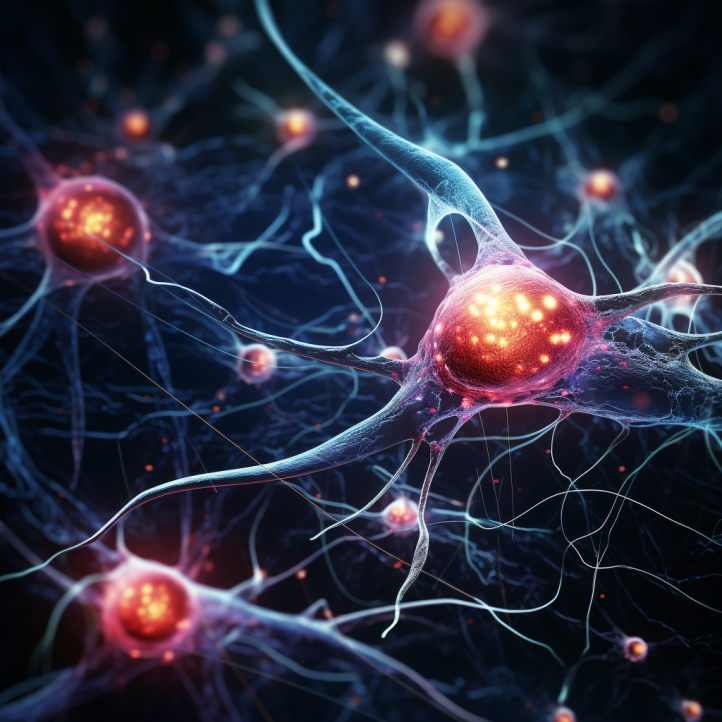Amphetamine is well known for its ability to increase dopamine levels in the brain.
But new research suggests the psychostimulant drug may also directly alter dopamine 2 receptors, with implications for behavioral effects and physiological changes seen after chronic amphetamine use.
Key facts:
- In cells expressing the dopamine transporter, prolonged amphetamine exposure decreased dopamine 2 receptors.
- In cells lacking the dopamine transporter, amphetamine increased dopamine 2 receptors at the cell membrane surface.
- The amphetamine-induced receptor changes altered downstream cAMP signaling.
- Effects occurred independently of dopamine, suggesting direct action on dopamine 2 receptors.
Source: Front Cell Neurosci. 2021
Amphetamine for ADHD & Dopamine Signaling
Amphetamine is commonly prescribed to treat ADHD (e.g. Adderall) and abused recreationally for its euphoric and performance-enhancing effects.
Its psychological and behavioral effects have long been linked to increased dopamine signaling.
Amphetamine enters dopamine neurons via the dopamine transporter, where it promotes dopamine efflux into the synapse through a combination of mechanisms.
The resulting surge in extracellular dopamine is believed to underlie amphetamine’s rewarding and reinforcing properties.
Dopamine binds to and activates dopamine receptors like the dopamine 2 receptor (D2R), triggering intracellular signaling cascades that modulate neuronal excitability and activity. D2Rs are located both pre- and post-synaptically.
Continuous D2R stimulation is known to cause receptor internalization and desensitization.
Considering amphetamine’s profound effects on dopamine, it is perhaps unsurprising that repeated or chronic amphetamine exposure can alter D2R expression and availability.
However, amphetamine is also lipophilic and can passively diffuse across cell membranes.
So can amphetamine directly affect D2Rs intracellularly or at the cell surface?
New research published in Frontiers in Cellular Neuroscience sought to investigate this question using human embryonic kidney (HEK293) cells.
Amphetamine Decreases D2Rs in Dopamine Transporter-Expressing Cells
The researchers first looked at how prolonged amphetamine exposure affects D2Rs in HEK293 cells expressing the human dopamine transporter (hDAT).
The hDAT transports amphetamine into the cell interior, mimicking the dopamine reuptake transporter found in dopamine neurons.
Cells were treated with a low or high concentration of amphetamine continuously for 15 hours.
Cell lysates were then analyzed by western blot using an antibody against human D2Rs.
This revealed a significant decrease in the D2R monomer band after amphetamine treatment compared to control cells.
These results indicate that when amphetamine access is mediated through hDAT, prolonged exposure causes downregulation of D2Rs.
This is likely an indirect effect stemming from amphetamine-induced dopamine efflux and D2R overstimulation.
Amphetamine Increases Plasma Membrane D2Rs Without Dopamine Transporter

Next, the researchers repeated the experiments in HEK293 cells lacking hDAT.
Although amphetamine diffusion is slower without hDAT, the psychostimulant can still cross the membrane given sufficient time and concentration.
Interestingly, the opposite effect was observed in these cells. 15 hours of amphetamine exposure significantly increased the D2R monomer band compared to control.
The researchers performed follow-up experiments to confirm the increased receptors were located at the plasma membrane surface.
Confocal imaging revealed increased co-localization of D2Rs with a cell membrane marker after amphetamine treatment.
Biochemical isolation of cell surface proteins verified this increase in membrane D2R expression.
The amphetamine-induced receptor increase was blocked when cells were co-treated with barbadin, an inhibitor of the β-arrestin adaptor complex involved in shuttling vesicular cargo like receptors to the membrane.
These findings indicate amphetamine can directly increase D2R trafficking to the cell surface independently of dopamine and dopamine transporter activity.
Increased D2Rs Alter Downstream cAMP Signaling
What are the functional implications of amphetamine-induced D2R changes?
D2Rs are inhibitory Gi-coupled receptors that reduce intracellular cAMP production when activated.
The researchers found that activating D2Rs with a specific agonist lowered cAMP levels more potently in amphetamine pre-treated cells compared to controls.
This effect was blocked by a D2R antagonist, confirming it was D2R-dependent.
Taken together, the results show the amphetamine-mediated increase in cell surface D2Rs has downstream consequences on intracellular signaling.
More D2Rs means more inhibition of the cAMP pathway.
Mechanisms: Direct Binding or Membrane Effects?
How might amphetamine directly alter D2R plasma membrane trafficking and expression?
The study did not definitively identify the mechanisms.
Direct binding is unlikely since amphetamine has low binding affinity for D2Rs.
The effects could result from amphetamine permeating the membrane and interacting with intracellular proteins involved in D2R regulation.
Alternatively, amphetamine partitioning into the membrane bilayer itself could alter the lipid microenvironment of D2Rs in a way that promotes receptor transport and stabilization at the cell surface.
Potential Benefits vs. Concerns of Amphetamine-Induced Dopamine Receptor Changes
Potential Benefits
- Compensation Mechanism: The increase in dopamine receptors might be a compensatory response of the cells to maintain dopamine sensitivity, especially in scenarios where dopamine levels have been altered for extended periods.
- Therapeutic Implications: For individuals with certain neurological or psychiatric conditions where dopamine receptor numbers or function are compromised, an increase in dopamine receptors might have therapeutic benefits.
Concerns
- Dysregulated Dopamine Signaling: The presence of a larger number of receptors could lead to exaggerated responses when dopamine is released. This might amplify the effects of dopamine, leading to overstimulation, which could manifest as increased anxiety, paranoia, or other behavioral changes.
- Tolerance Development: Over time, the increased number of receptors might become the new “norm” for the cell. When the drug is not present, the individual might feel dysphoric or functionally low due to the relative lack of dopamine activation for the higher number of receptors, potentially leading to drug-seeking behavior.
- Potential for Addiction: Changes in the dopamine system, especially the reward pathway, are central to the process of addiction. An increase in dopamine receptors might influence the addictive potential of amphetamines, making it harder for individuals to quit once they’ve started.
- Altered Cognitive and Behavioral Effects: With more receptors, the effects of dopamine could change, leading to cognitive and behavioral changes. This might manifest as altered attention, memory, or decision-making processes, or even mood swings.
- Downregulation Over Time: The body often responds to sustained increases in receptor levels by eventually downregulating them, either reducing their numbers or making them less sensitive. This could lead to decreased dopamine function over the long term, which has its own set of complications.
Dopamine-Independent D2R Changes: Implications for Long-Term Use
The findings have important implications for understanding the effects of repeated amphetamine exposure.
Most research has focused on dopamine-dependent D2R changes.
But this study demonstrates amphetamine can also directly modulate D2Rs in the absence of dopamine, including at post-synaptic membranes lacking dopamine transporters.
With chronic amphetamine use, constantly elevated extracellular dopamine levels drive compensatory D2R downregulation.
When amphetamine is withdrawn, low D2R density contributes to cravings and addiction.
The present research highlights another mechanism by which amphetamine alters D2Rs independently of dopamine – by direct trafficking changes that increase membrane receptors.
This could sustain D2R signaling even when dopamine stores are depleted after chronic amphetamine abuse.
The direct receptor effects may also contribute to altered behavioral responses and receptor sensitization.
More Questions: Glycosylation, Brain Relevance, and Behavior
Like most initial cell culture studies, the research raises many additional questions.
An interesting finding was that amphetamine preferentially increased the non-glycosylated D2R monomer.
- How does preventing D2R glycosylation facilitate amphetamine’s effects?
- Do similar direct interactions occur in the brains of living animals and humans?
- Are the behavioral consequences the same or different?
- What changes in D2R-mediated behaviors, reward sensitivity, and addiction vulnerability might result from chronic use? Do benefits of ADHD treatment decline faster?
The study provides a framework to begin investigating these important questions about how amphetamine alters dopamine receptor biology by mechanisms independent of dopamine itself.
Human cell cultures are imperfect models, but they allow precise control over variables like dopamine and transporter presence.
This simplifies studying direct drug-receptor interactions difficult to isolate in complex brains.
Unraveling the multiple ways amphetamine affects dopamine signaling will lead to a more complete understanding of the physiology underlying its widespread psychological impacts.
References
- Study: Prolonged amphetamine exposures increase the endogenous human dopamine receptors 2 at the cellular membrane in cells lacking the dopamine transporter
- Authors: Vindhya Nawaratne et al. (2021)







